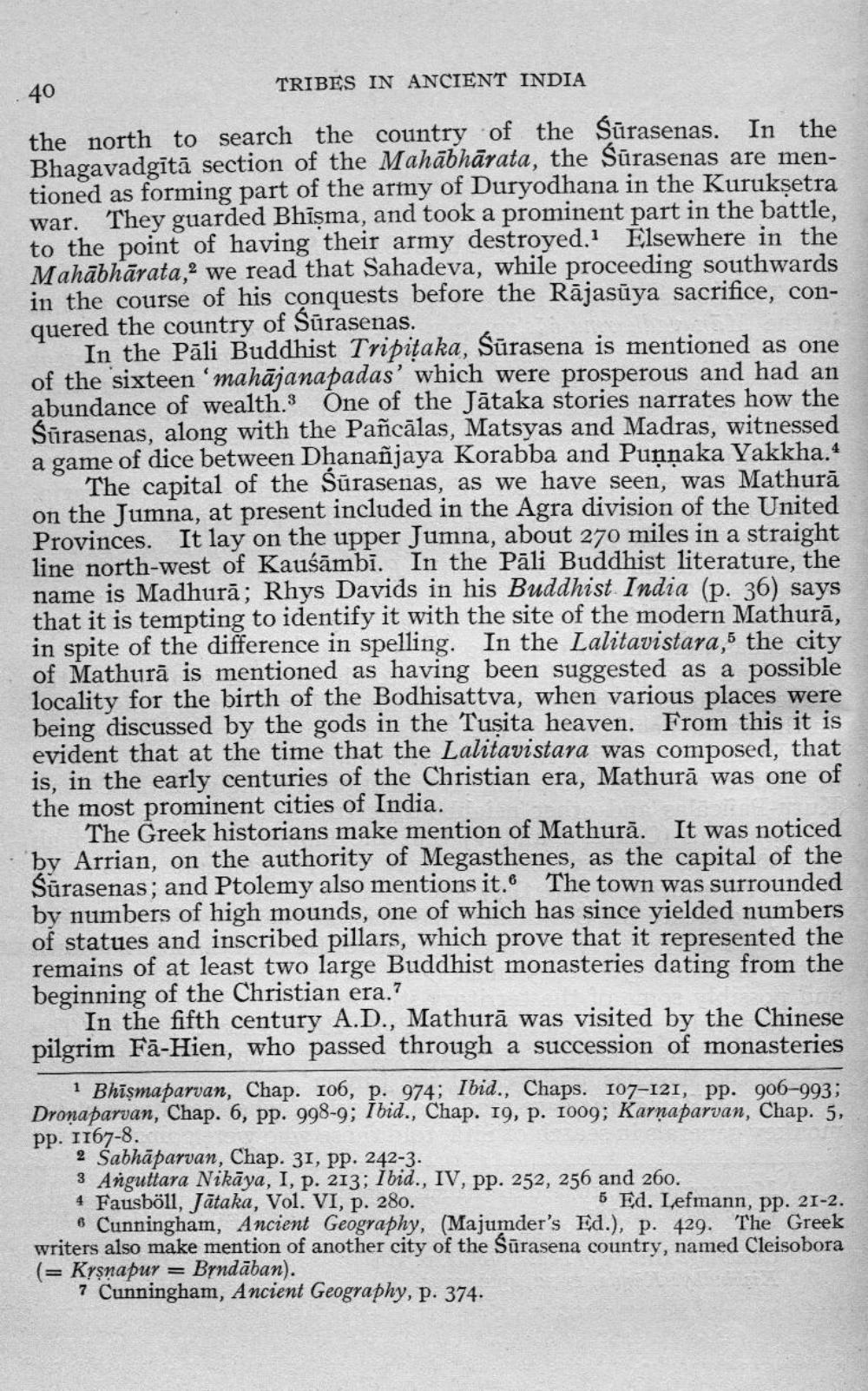________________
40
TRIBES IN ANCIENT INDIA the north to search the country of the Sūrasenas. In the Bhagavadgitā section of the Mahābhārata, the Sūrasenas are mentioned as forming part of the army of Duryodhana in the Kuruksetra war. They guarded Bhīşma, and took a prominent part in the battle, to the point of having their army destroyed.1 Elsewhere in the Mahābhārata, we read that Sahadeva, while proceeding southwards in the course of his conquests before the Rājasūya sacrifice, conquered the country of Sūrasenas.
In the Pāli Buddhist Tripitaka, Śūrasena is mentioned as one of the sixteen 'mahājanapadas' which were prosperous and had an abundance of wealth. One of the Jātaka stories narrates how the Śūrasenas, along with the Pañcālas, Matsyas and Madras, witnessed a game of dice between Dhananjaya Korabba and Punnaka Yakkha.4
The capital of the Sūrasenas, as we have seen, was Mathurā on the Jumna, at present included in the Agra division of the United Provinces. It lay on the upper Jumna, about 270 miles in a straight line north-west of Kausāmbi. In the Pāli Buddhist literature, the name is Madhurā; Rhys Davids in his Buddhist India (p. 36) says that it is tempting to identify it with the site of the modern Mathurā, in spite of the difference in spelling. In the Lalitavistara,5 the city of Mathurā is mentioned as having been suggested as a possible locality for the birth of the Bodhisattva, when various places were being discussed by the gods in the Tuşita heaven. From this it is evident that at the time that the Lalitavistara was composed, that is, in the early centuries of the Christian era, Mathurā was one of the most prominent cities of India.
The Greek historians make mention of Mathurā. It was noticed by Arrian, on the authority of Megasthenes, as the capital of the Sūrasenas; and Ptolemy also mentions it. The town was surrounded by numbers of high mounds, one of which has since yielded numbers of statues and inscribed pillars, which prove that it represented the remains of at least two large Buddhist monasteries dating from the beginning of the Christian era.?
In the fifth century A.D., Mathurā was visited by the Chinese pilgrim Fä-Hien, who passed through a succession of monasteries
1 Bhīşmaparvan, Chap. 106, p. 974; Ibid., Chaps. 107-121, pp. 906-993; Dronaparvan, Chap. 6, pp. 998-9; Ibid., Chap. 19, P. 1009; Karnaparvan, Chap. 5, pp. 1167-8.
2 Sabhāparvan, Chap. 31, pp. 242-3. 3 Anguttara Nikāya, I, p. 213; Ibid., IV, pp. 252, 256 and 260. 4 Fausböll, Jataka, Vol. VI, P. 28o.
5 Ed. Lefmann, pp. 21-2. 6 Cunningham, Ancient Geography, (Majumder's Ed.), p. 429. The Greek writers also make mention of another city of the Sürasena country, named Cleisobora (= Kysnapur = Brndāban).
7 Cunningham, Ancient Geography, p. 374.




